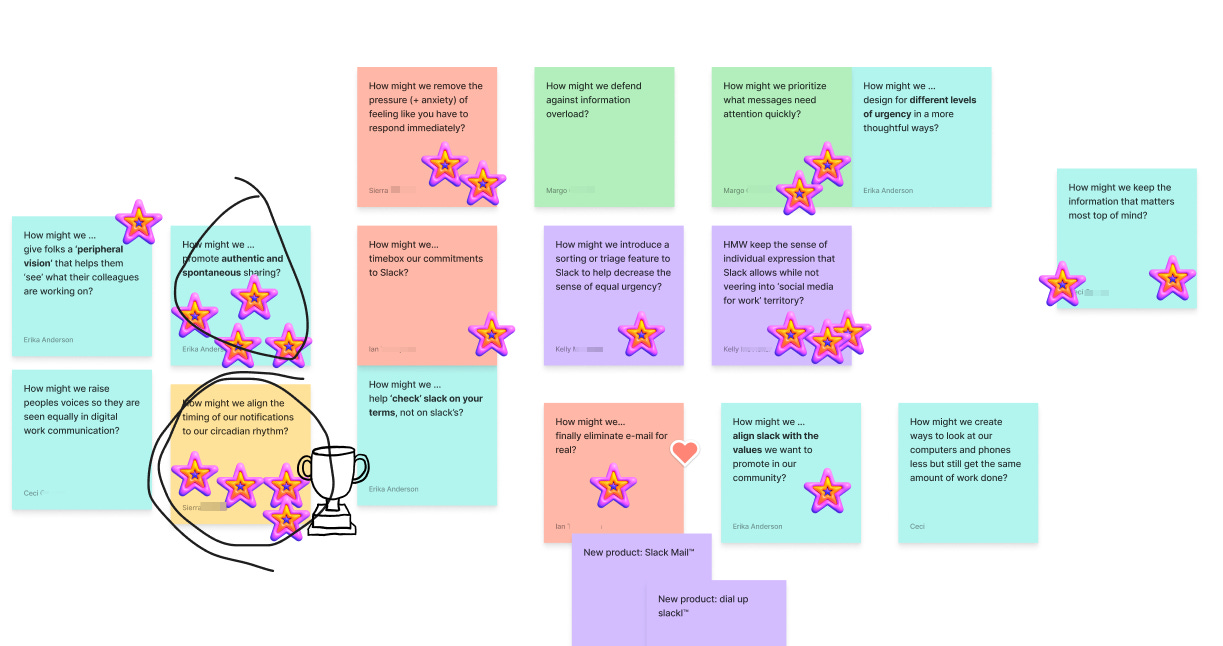IDEO x Building Humane Tech: Creating a more humane version of Slack
What happens when we give ourselves permission to rethink the defaults?
In August, I began exploring what it means to redesign familiar platforms—ChatGPT, Slack, X/Twitter (and more recently, Facebook)—through the lens of humane technology. In February, it expanded into something more collaborative.
IDEO invited me to lead a hands-on session on reimagining workplace technology. Instead of staying in idea land, we rolled up our sleeves and got building—using Slack as our canvas to explore what humane digital collaboration could look like.
Evaluating Slack: Where does it help? Where does it harm?
We opened by mapping Slack against a humane design framework from the Center for Humane Technology. We evaluated Slack across six key dimensions:
Emotional and physical well-being – Does it support calm and regulation or trigger stress and reactivity?
Attention – Does it protect our ability to focus or fragment it with constant demands?
Sense-making – Does it help users understand what's happening or overwhelm them with noise?
Decision-making – Does it support thoughtful choices or lead to impulsive reactions?
Group dynamics – Does it encourage cooperation and healthy interaction or increase friction and status anxiety?
Social reasoning – Does it help us interpret others with empathy or create misalignment and mistrust?
Using a FigJam board, we rated each category based on our experience. Unsurprisingly, attention and emotional impact scored lowest. But others, like group dynamics, landed more neutrally.
One participant shared,
“I turned off Slack notifications on vacation and never turned them back on.”
Followed by a quiet cheer of recognition.
From “How might we…” to prototypes
IDEO designers came ready to play. Using how might we prompts, they moved quickly from constraints to creative possibility—generating ideas that were grounded, whimsical, and sometimes both.
Here are just a few that stood out:
Slack Be Real
A daily, team-level prompt sent at a random time: Share a quick photo, a note, or a reflection—something human, not necessarily work-related.
“It helps you find those little glimmers in your day.”
It echoed analog rituals—tea time, sunset sharing—made digital in a way that still felt personal.
Circadian-aligned notifications
Why should Slack treat 2 p.m. the same as 10 p.m.? This concept proposed syncing notifications to our bodies:
Batch updates during deep work blocks
Pause pings in the evening
Let teams define their own rhythms
Not about shutting off—about aligning.
Slack, embodied
What if Slack wasn’t just digital? IDEO let the ideas fly:
Slack Tubes (yes, pneumatic ones)
Slack Paper, a weekly digest you could hold
Slack Postcards, for sending physical notes between teammates
A reminder that touch, texture, and tangibility still matter—even in remote-first spaces.
Urgency with nuance
We’re living in a world where everything feels urgent. This redesign challenge focused on adding clarity instead of pressure:
Tags like “top of mind, no reply needed”
Self-expiring pins
Priority labels visible only to you
Little shifts, big impact
Building for better defaults
What stood out wasn’t just the creativity. It was the willingness to suspend “the way things are” and imagine tools that support:
Spaciousness over stress
Embodiment over overload
Connection over performance
Humane tech asks us not just what’s possible but what’s needed—for our attention, our relationships, and our capacity to be human in digital spaces.
What’s next
If you'd like to explore this kind of thinking in your own work or team, let’s connect. Or come to an upcoming Humane Tech Meetup.
If your team could co-create a new norm in how you use Slack, what would it look like?
Let’s keep building toward what’s possible.








